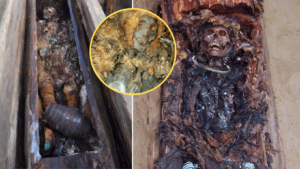The woman, who passed away 2,200 years ago, is thought to have held significant esteem within her tribe, evident in her burial adorned with exquisite garments and jewelry.
Researchers assert that the woman belonged to the Celtic culture. During the Iron Age, Celts were recognized for interring tribe members in elaborate “tree coffins” placed in subterranean locations.

Discovered in the city of Zurich in 2017, the woman’s remains were adorned in a luxurious ensemble, including a fine woolen dress, shawl, sheepskin coat, and a necklace crafted from glass and amber beads. Researchers speculate that she likely engaged in minimal, if any, strenuous labor during her lifetime. Estimated to be around 40 years old at the time of her death, an examination of her teeth revealed a penchant for sweets.
Her prestigious social standing is further evidenced by the bronze bracelets, bronze belt chain with iron clasps and pendants that adorned her. Bone analysis indicates that she grew up in what is now modern-day Zurich, likely in the Limmat Valley.

Beyond her remarkable garments and accessories, what captivates the imagination is the ingeniously repurposed hollowed-out tree trunk serving as her coffin. Initially stumbled upon by construction workers in 2017, it retained its original bark exterior, as reported by Zurich’s Office of Urban Development in the same year.
While the immediate discoveries—an Iron Age Celtic woman’s remains, her intriguing attire, and the creatively crafted coffin—are fascinating in their own right, subsequent research since 2017 has revealed even more. According to The Smithsonian, the excavation site has long been recognized as archaeologically significant. However, most previous findings in this location only extend back to the 6th century A.D.

An unusual departure from the norm took place in 1903 when construction workers unearthed the burial site of a Celtic man. The discovery occurred during the construction of the school complex’s gym, as reported by the Office of Urban Development. The man’s remains were found alongside a sword, shield, and lance.
Presently, researchers are strongly entertaining the possibility that the Celtic woman, whose remains were discovered a mere 260 feet from the man’s grave, might have been acquainted with him. Experts suggest that both individuals were laid to rest in the same decade, a hypothesis deemed “quite possible” by the Office of Urban Development.

Despite previous discoveries of evidence indicating a nearby Celtic settlement dating back to the 1st century B.C., researchers now believe that the man found in 1903 and the woman found in 2017 were part of a smaller, distinct community yet to be fully explored.
In line with their 2017 press release, the department’s researchers thoroughly examined the grave and its contents. The meticulous process involved salvaging and conserving relevant items, comprehensive documentation, and both physical and isotope-based examinations on the woman.
Notably, experts were particularly impressed by the woman’s necklace, adorned with impressive clasps on either end. The concluded assessment, according to the office, “draws a fairly accurate picture of the deceased” and her community. Isotope analysis confirmed that she was buried in the same area where she grew up.
While Celts are commonly associated with the British Isles, they inhabited various parts of Europe for centuries. Some clans settled in Austria, Switzerland, and other regions north of the Roman Empire. Intriguingly, during the exact timeframe of 450 B.C. to 58 B.C. when the Celtic woman and man were buried, the region of Lac de Neuchâtel in Switzerland witnessed the flourishing of the La Tène culture—an eclectic group known for their wine consumption, gold design, poly/bisexual practices, and naked warrior battles.
This cultural richness continued until Julius Caesar initiated the invasion of the area, marking the conquest of western and northern Europe. Ultimately, the Celtic woman received a compassionate burial, departing Earth with her most cherished possessions by her side.






